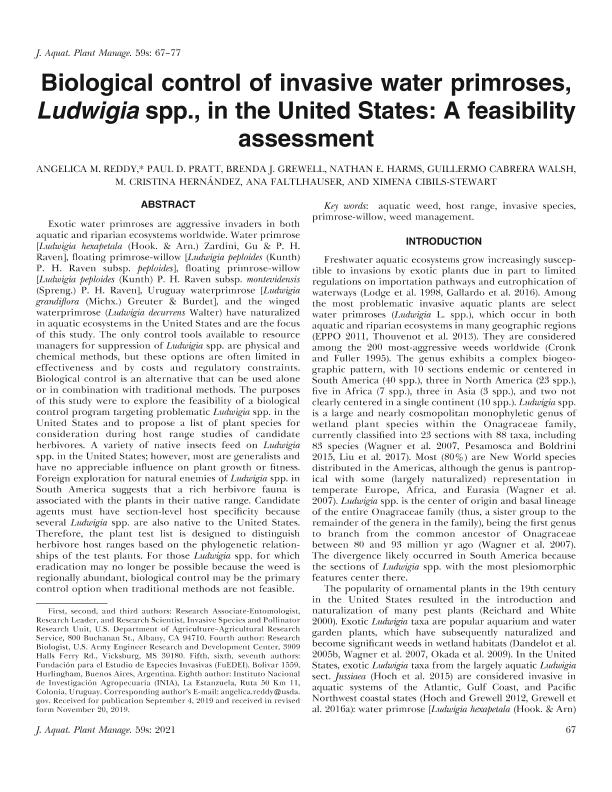Mostrar el registro sencillo del ítem
dc.contributor.author
Reddy, Angelica M.
dc.contributor.author
Pratt, Paul

dc.contributor.author
Grewell, Brenda J.
dc.contributor.author
Harms, Nathan E.
dc.contributor.author
Cabrera Walsh, Guillermo José

dc.contributor.author
Hernández, María Cristina

dc.contributor.author
Faltlhauser, Ana Claudia

dc.contributor.author
Cibils Stewart, Ximena
dc.date.available
2024-02-28T13:04:33Z
dc.date.issued
2021-07
dc.identifier.citation
Reddy, Angelica M.; Pratt, Paul; Grewell, Brenda J.; Harms, Nathan E.; Cabrera Walsh, Guillermo José; et al.; Biological control of invasive water primroses, Ludwigia spp., in the United States: A feasibility assessment; Aquatic Plant Management Soc, Inc; Journal Of Aquatic Plant Management; 59; 7-2021; 67-77
dc.identifier.issn
0146-6623
dc.identifier.uri
http://hdl.handle.net/11336/228776
dc.description.abstract
Exotic water primroses are aggressive invaders in both aquatic and riparian ecosystems worldwide. Water primrose [Ludwigia hexapetala (Hook. & Arn.) Zardini, Gu & P. H. Raven], floating primrose-willow [Ludwigia peploides (Kunth) P. H. Raven subsp. peploides], floating primrose-willow [Ludwigia peploides (Kunth) P. H. Raven subsp. montevidensis (Spreng.) P. H. Raven], Uruguay waterprimrose [Ludwigia grandiflora (Michx.) Greuter & Burdet], and the winged waterprimrose (Ludwigia decurrens Walter) have naturalized in aquatic ecosystems in the United States and are the focus of this study. The only control tools available to resource managers for suppression of Ludwigia spp. are physical and chemical methods, but these options are often limited in effectiveness and by costs and regulatory constraints. Biological control is an alternative that can be used alone or in combination with traditional methods. The purposes of this study were to explore the feasibility of a biological control program targeting problematic Ludwigia spp. in the United States and to propose a list of plant species for consideration during host range studies of candidate herbivores. A variety of native insects feed on Ludwigia spp. in the United States; however, most are generalists and have no appreciable influence on plant growth or fitness. Foreign exploration for natural enemies of Ludwigia spp. in South America suggests that a rich herbivore fauna is associated with the plants in their native range. Candidate agents must have section-level host specificity because several Ludwigia spp. are also native to the United States. Therefore, the plant test list is designed to distinguish herbivore host ranges based on the phylogenetic relationships of the test plants. For those Ludwigia spp. for which eradication may no longer be possible because the weed is regionally abundant, biological control may be the primary control option when traditional methods are not feasible.
dc.format
application/pdf
dc.language.iso
eng
dc.publisher
Aquatic Plant Management Soc, Inc

dc.rights
info:eu-repo/semantics/openAccess
dc.rights.uri
https://creativecommons.org/licenses/by-nc-sa/2.5/ar/
dc.subject
AQUATIC WEED
dc.subject
HOST RANGE
dc.subject
INVASIVE SPECIES
dc.subject.classification
Conservación de la Biodiversidad

dc.subject.classification
Ciencias Biológicas

dc.subject.classification
CIENCIAS NATURALES Y EXACTAS

dc.title
Biological control of invasive water primroses, Ludwigia spp., in the United States: A feasibility assessment
dc.type
info:eu-repo/semantics/article
dc.type
info:ar-repo/semantics/artículo
dc.type
info:eu-repo/semantics/publishedVersion
dc.date.updated
2024-02-27T14:48:34Z
dc.journal.volume
59
dc.journal.pagination
67-77
dc.journal.pais
Estados Unidos

dc.description.fil
Fil: Reddy, Angelica M.. United States Department of Agriculture; Estados Unidos
dc.description.fil
Fil: Pratt, Paul. United States Department of Agriculture; Estados Unidos
dc.description.fil
Fil: Grewell, Brenda J.. United States Department of Agriculture; Estados Unidos
dc.description.fil
Fil: Harms, Nathan E.. U.s. Army Engineer Research And Development Center; Estados Unidos
dc.description.fil
Fil: Cabrera Walsh, Guillermo José. Fundación para el Estudio de Especies Invasivas; Argentina
dc.description.fil
Fil: Hernández, María Cristina. Fundación para el Estudio de Especies Invasivas; Argentina
dc.description.fil
Fil: Faltlhauser, Ana Claudia. Consejo Nacional de Investigaciones Científicas y Técnicas; Argentina. Fundación para el Estudio de Especies Invasivas; Argentina
dc.description.fil
Fil: Cibils Stewart, Ximena. Instituto Nacional de Investigacion Agropecuaria;
dc.journal.title
Journal Of Aquatic Plant Management

dc.relation.alternativeid
info:eu-repo/semantics/altIdentifier/url/https://apms.org/wp-content/uploads/japm-59-01s-67.pdf
Archivos asociados
